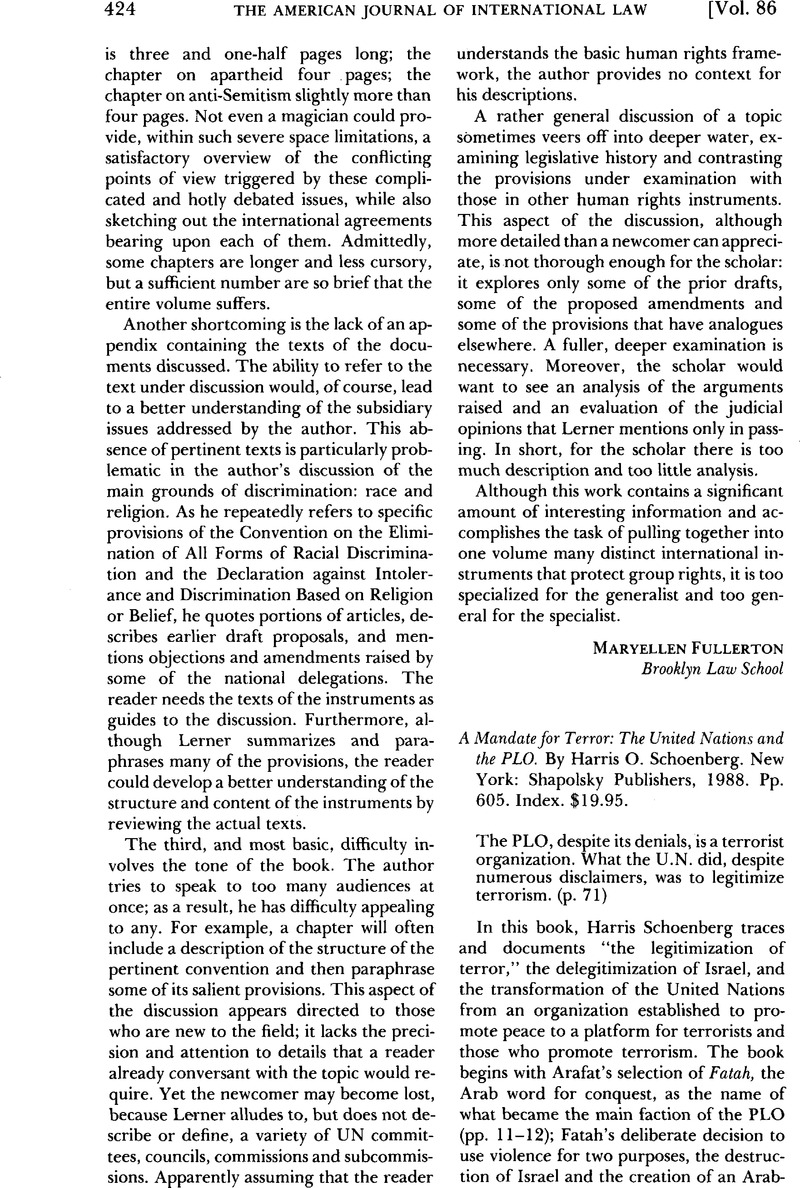No CrossRef data available.
Article contents
A Mandate for Terror: The United Nations and the PLO. By Harris O. Schoenberg. New York: Shapolsky Publishers, 1988. Pp. 605. Index. $19.95.
Published online by Cambridge University Press: 27 February 2017
Abstract

- Type
- Book Reviews and Notes
- Information
- Copyright
- Copyright © American Society of International Law 1992
References
1 Among the authorities cited are Count Ber- nadotte, the UN mediator, who wrote in 1948 that the “Palestinian Arabs have [never] devel oped any specifically Palestinian nationalism” (p. 14), and Zuhayr Muhsin, the head of the PLO Military Department till 1979, who stated in 1977: “actually there are no differences among Jordanians, Palestinians, Syrians, and Lebanese. We all constitute a part of one people. We speak about a Palestinian identity only for political rea sons because the Arab national interest is to en courage a separate Palestinian existence . . ."(p. 15).
2 In 1972, when the proposal was made, in ad dition to the massacre of 11 Israeli athletes at the Munich Olympics and the murder of 26 tourists at Lod Airport, acts of terrorism, such as aerial hijackings and bombing, were committed against 30 airlines of 14 countries (p. 72).
3 Eain had a hearing before a U.S. magistrate, a hearing before a U.S. district court and review by a U.S. court of appeals and by the Secretary of State before he was extradited. See Eain v. Wilkes, 641 F.2d 504 (7th Cir.), cert, denied, 454 U.S. 894(1981).
4 Schoenberg states (p. 260): In 1981, for example, [the Security Council] met 60 times but failed to deal even once with the Soviet invasion of Afghanistan, with Vietnam's invasion of Kampuchea (Cambodia), with Iraq's invasion of Iran, or with Libya's invasion of Chad. Instead, 21 of its 45 meetings devoted to substantive issues dealt with complaints by the PLO or Arab states against Israel. From June to August of 1982, the Council adopted 10 resolutions dealing with Israel's strike against the PLO in Lebanon. But in the previous seven years it adopted not a single one dealing with the carnage in Lebanon brought about by the PLO and Syria. Passed over were 100,000 deaths and widespread devastation of sections of Beirut and more than 100 Lebanese villages.
5 See, e.g., p. 261, quoting the PLO representa tive: “The Israelis are the masters of repression, murder, expulsion, and torture. The world has rarely seen the like of such a horrifying state, which more and more resembles Nazi Ger many."
6 For a more detailed discussion of this issue, see Halberstam, Excluding Israel from the General Assembly by a Rejection of its Credentials, 78 AJIL 179 (1984); Tabory, Universality of the U.N., 19 ISRAEL Y.B. HUM. RTS. 189 (1989).
7 The resolution's pernicious effects have extended not only to states that needed an excuse for their anti-Semitism and found a justification in this United Nations resolution, but even to well-meaning students on the campuses of U.S. universities. When I was visiting at the University of Virginia, an article in the school newspaper referring to a letter received by a professor stated, “the writer incorrectly assumed [the professor] was a Zionist and thus a racist.” (Cavalier Daily, Feb. 4, 1976.) The implication clearly was that had the writer been correct in his assumption that she was a Zionist, he would have been correct in concluding that she was a racist.
8 A UN pamphlet (quoting from the Peel Com mission report of 1937) states that worse for Pal estinians than not having a state of their own was the “intolerable prospect of ajewish state.” See p. 378 and p. 537 n.12.
9 These range from references to Israel as a "Judaeo-Nazi state” (p. 251), to fabricated claims that Israel is poisoning Arab schoolchildren (tests by outside organizations found no evidence of poisoning (pp. 253-54)), to an assertion that "Jews kidnap and slaughter a non-Jewish boy each year and drain his blood” (p. 325).


